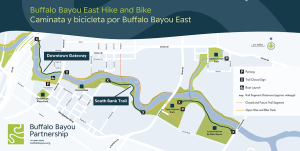Trails & Destinations
Trails &
Destinations
Our work weaves together wide-open parks and tree-lined trails with repurposed buildings and reimagined industrial relics that serve as welcoming public spaces for art and play, as well as waterfront portals to Houston’s diverse history and neighborhoods.

explore all of our spaces.
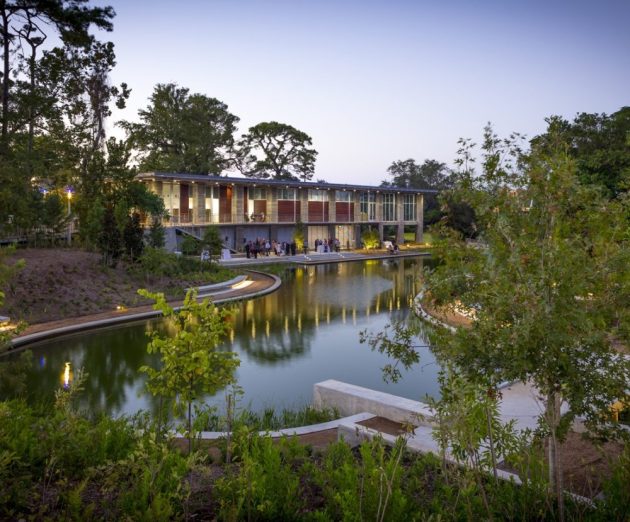

Lost Lake is the site of a former pond that was lost in the 1970s, when its dam across a natural ravine broke. The pond was restored and is now a tranquil area for reflection, surrounded by beautiful plantings and gentle cascades. Visitors will also find public restrooms and a restaurant here.
FLORA Restaurant at Lost Lake
Please visit the FLORA website for reservations and information.
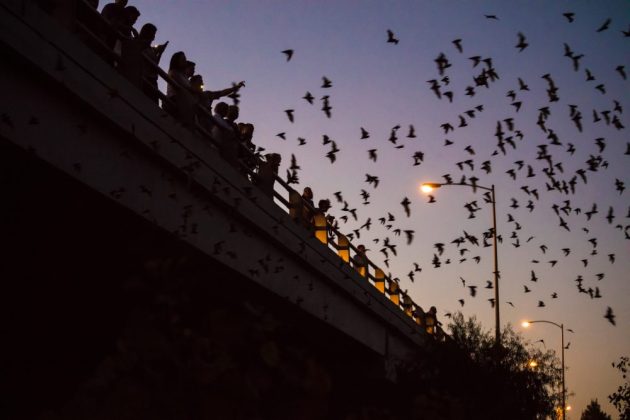

Watching more than 300,000 Mexican free-tailed bats emerge every evening from the crevices of the Waugh Drive Bridge is truly a spectacular sight. Unlike in other colonies, a large number of these bats remain through the winter months, providing viewing opportunities on warm nights. Stop by at sunset to witness this natural wonder and learn more about the bats through interpretive signage at the viewing platform.
Bat Chats
The Houston Bat Team hosts Bat Chats every Friday, April through October. Please arrive 30 minutes before sunset and meet at the viewing platform at the corner of Waugh Drive and Allen Parkway. Check their Facebook for updates.
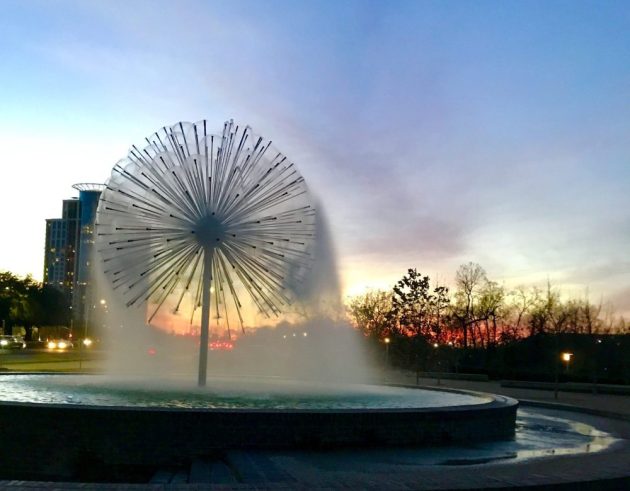

At the center of this grove is the Gus S. Wortham Memorial Fountain, affectionately known as the “Dandelion.” The fountain’s brass starburst of pipes sprays joggers, cyclists, and walkers, offering a cool respite from the heat. With shaded overlooks and beautiful plantings, the area is a favorite meeting spot.
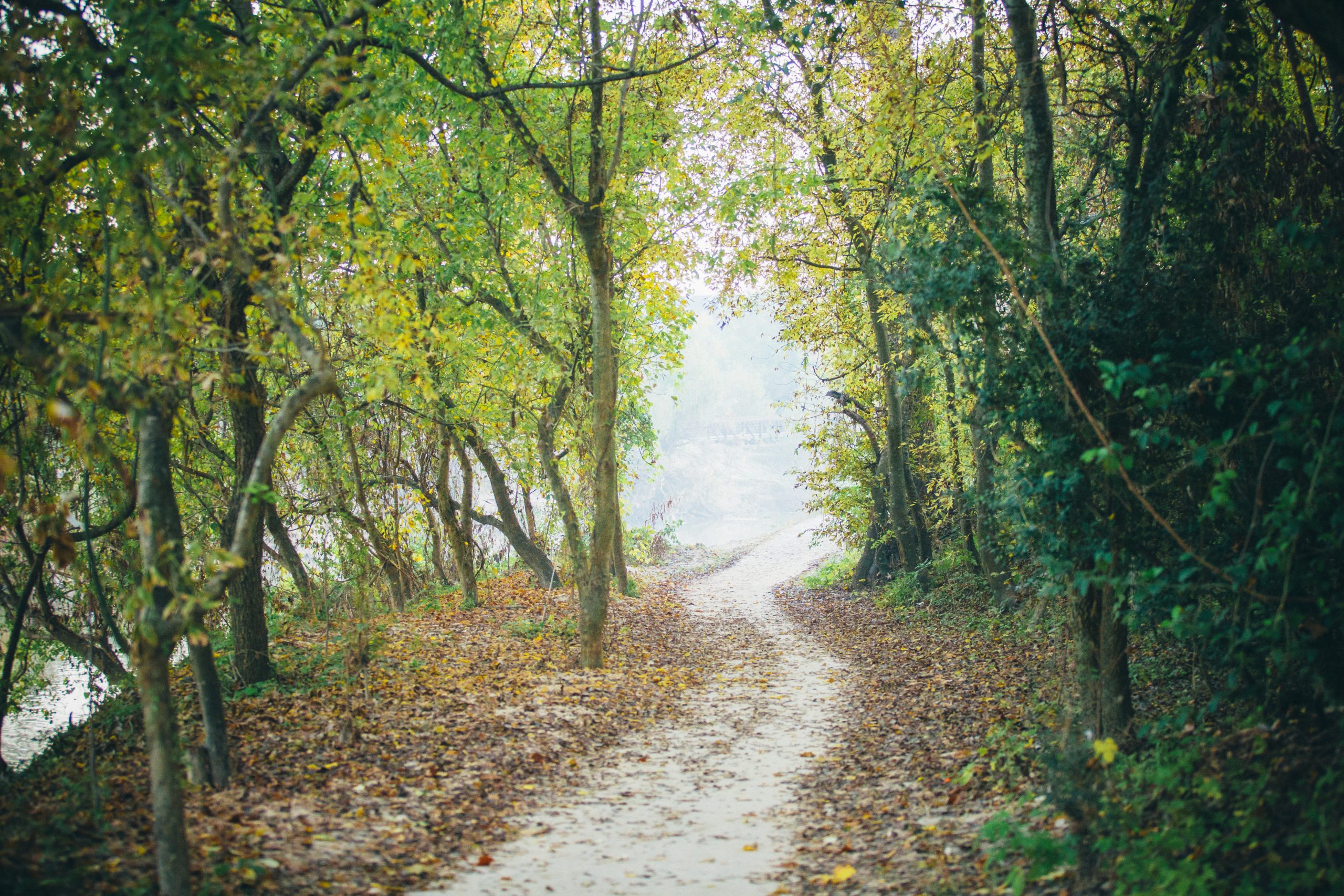

Unless you know it’s there, the Green Tree Nature Area may be difficult to find. Located south of Memorial Drive at Waugh Drive, this heavily forested trail is a nature lover’s delight. You will find birds, squirrels, and even a rabbit or two on any given day.
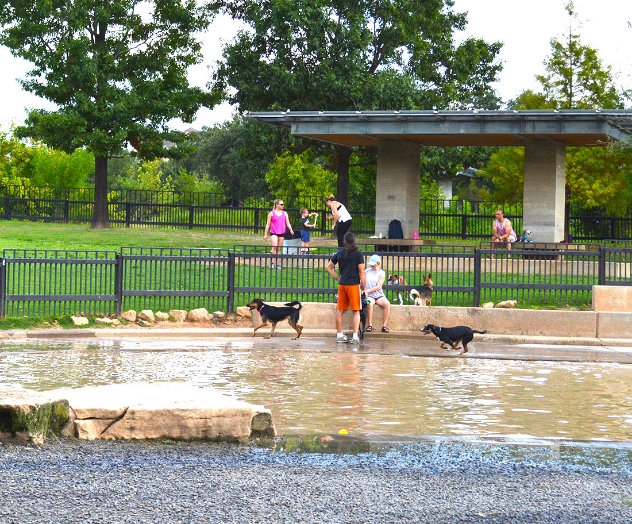

One of Buffalo Bayou Park’s most beloved destinations is the Johnny Steele Dog Park. Dogs have plenty of space to run, swim, and play, while their owners can relax on benches and take advantage of dog washing stations and drinking fountains (complete with spigots for dogs). Limited parking for the dog park is available along the frontage road of Allen Parkway.
DOG PARK REGULATIONS
Hours: 7am – 8pm (may be closed during bad weather or for maintenance)
Closed for maintenance and cleaning Tuesdays 7am – 4pm and Fridays 1 – 2:30pm
The above schedule is subject to change based on cleaning and maintenance needs. Check this page or BBP social media for additional updates.
Help us keep this popular destination safe for dogs and their owners by adhering to these rules:
- Owners are liable for damage or injury inflicted by their dog(s). This means owners are legally and financially responsible for their dog’s behavior. Buffalo Bayou Partnership and the City of Houston have no liability or responsibility for injuries in the dog park.
- Limit of two dogs per person per visit and one hour for each dog.
- Dogs taller than 15 inches may not use the small dog area.
- Dogs must be properly licensed and vaccinated with City of Houston registration and rabies tags visible on each dog’s collar.
- Dogs must be leashed before entering and upon leaving the dog park and must be leashed in the transition area. Owners must have a visible leash for each dog at all times.
- Owners must have disposable pet waste materials visible at all times and must pick up their dog’s fecal matter and dispose of it in a trash receptacle.
- Owners must have verbal and sight control of their dog(s) at all times and prevent aggressive behavior, fighting, biting, and aggressive barking. Never leave your dog(s) unattended.
- Dogs with a known history of dangerous behavior are prohibited. Immediately leash your dog and leave the park if your dog(s) behaves aggressively.
- No puppies under four months of age are allowed in the dog park.
- No female dogs in heat are allowed in the dog park.
- No children aged 12 or under are allowed in the dog park. An adult must accompany children ages 13 through 18. Permitted children must be supervised by an adult and behave appropriately. No running, shouting, chasing dogs, or petting other people’s dogs without their permission.
- No dog or people food is allowed in the dog park.
- No smoking in the dog park or elsewhere in the park.
- Violation of the City Code results in fines and no further dog park use.


Late Texas artist Jesús Bautista Moroles’ Houston Police Officers’ Memorial commemorates the 113+ Houston Police Department officers whose lives were lost in the line of duty. Shaped like an Aztec pyramid, the sculpture symbolizes a royal tomb. The Police Officers’ Memorial and surrounding grounds are guarded 24 hours a day. This is also the site of an annual procession and wreath-laying ceremony.
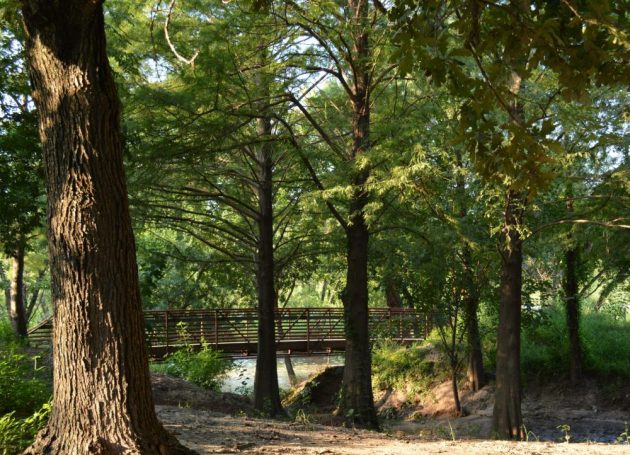

The late Houston landscape architect Charles Tapley originally designed this inspirational site in the late 1970s that now features a bayou tributary, riparian plantings, granite steps, seating areas, and a footbridge.


Named in honor of the late City Council Member and civic activist Eleanor Tinsley, this “park within a park” is one of Houston’s most popular outdoor spaces with the signature Bud Light Amphitheater lawn and open-air Nau Family Pavilion. Visitors can also enjoy the Eleanor Tinsley Garden and the tranquil Jane Gregory Garden nearby.
Volleyball Court Rentals
The sand volleyball court at Eleanor Tinsley Park is available to rent here.
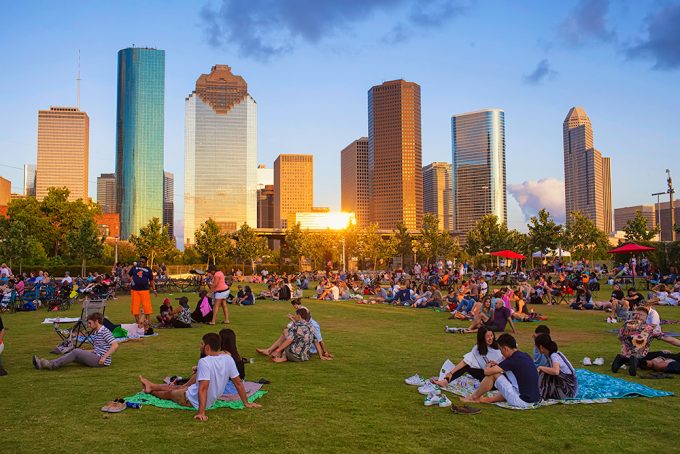

Here, you will find the Wortham Insurance Visitor Center with restrooms, bike rentals, and staff available to answer your questions and provide directions. Visitors can also enjoy food trucks, stunning views of the downtown skyline from The Brown Foundation Lawn, and frequent performances and events at the Hobby Family Pavilion.
Learn more about renting The Water Works for your own event here.
VISITOR CENTER
Open daily from 9am – 6pm
RESTROOMS
Open daily from 8am – 8pm
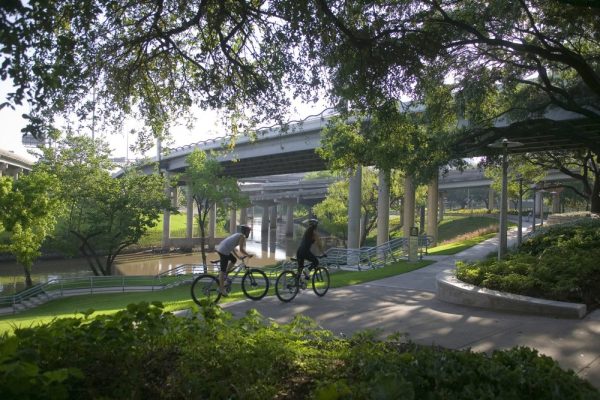

The Buffalo Bayou trail system winds through this 23-acre waterfront destination that lies just east of Buffalo Bayou Park. Visitors will find stainless steel boat sculptures by Houston artist John Runnels at major park entrances, BBP’s signature Lunar Cycle Lighting, and the Hobby Pedestrian Bridge, among other features.
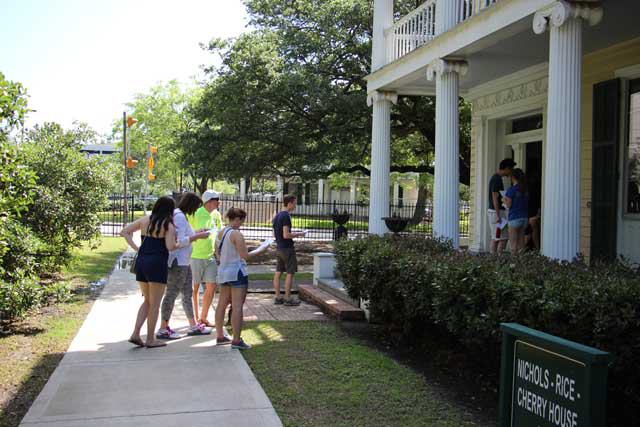

This historic park, created in 1899 by Mayor Sam Brashear, was originally landscaped like a Victorian village. Today it is home to The Heritage Society, an organization devoted to preserving a collection of Houston’s historic structures. Nine buildings have been restored and relocated to Sam Houston Park that together tell the story of Houstonians throughout the city’s past.
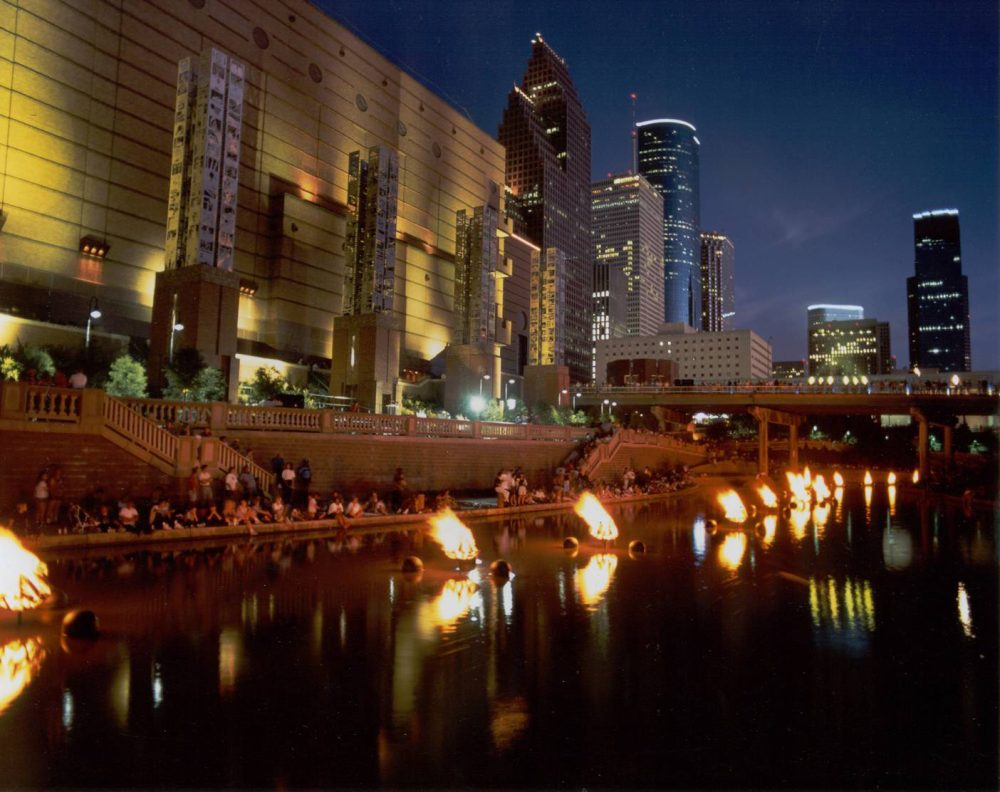

This 22-acre park is the centerpiece of downtown’s Theater District and commemorates Houston’s 150th birthday. Visitors can stroll along the promenade and take in the public art in the park, including artist Mel Chin’s monumental stainless steel pillars, Seven Wonders.
A bronze statue of former Secretary of State James A. Baker III gazes from the Baker Common across Buffalo Bayou at a statue of former President George H.W. Bush. North Carolina sculptor Chas Fagan created both statues.
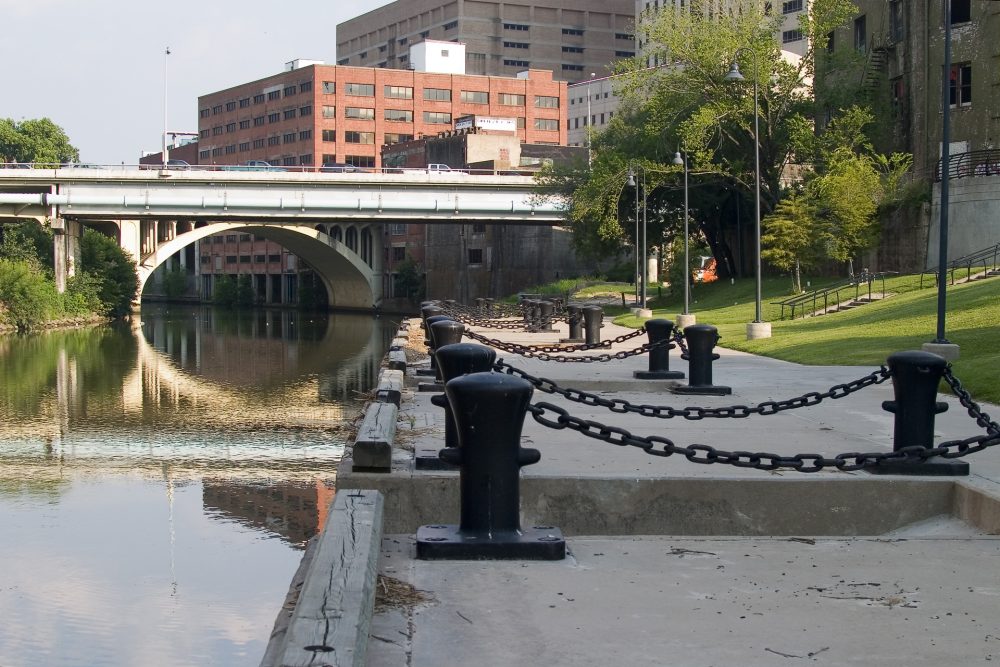

Allen’s Landing marks the spot where August Chapman and John Kirby Allen stepped ashore in 1836 and began the transformation of the area from swampy marshlands to the city we know today. This site, at the confluence of Buffalo and White Oak Bayous, became Houston’s first port and a thriving commercial hub. After years of neglect, BBP revitalized this historic site and park into an active waterfront destination. Stainless steel canoe sculptures by John Runnels grace the entrances to the space, and visitors can walk along the wharf where they will find public text art designed by local artist team, ttweak.
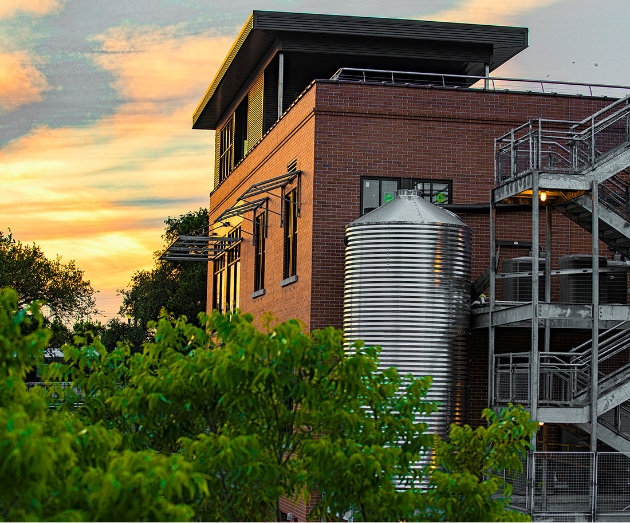

The Sunset Coffee Building at Allen’s Landing was built in 1910 by merchant William D. Cleveland to house his coffee roasting operations. It is one of the few remaining industrial buildings on Buffalo Bayou within downtown Houston’s Historic District.
BBP renovated the building in cooperation with Houston First. This industrial building houses BBP’s administrative offices as well as three unique event spaces available to rent, including an indoor space with a balcony overlooking the bayou, a large outdoor plaza, and an intimate rooftop terrace with stunning views of downtown.
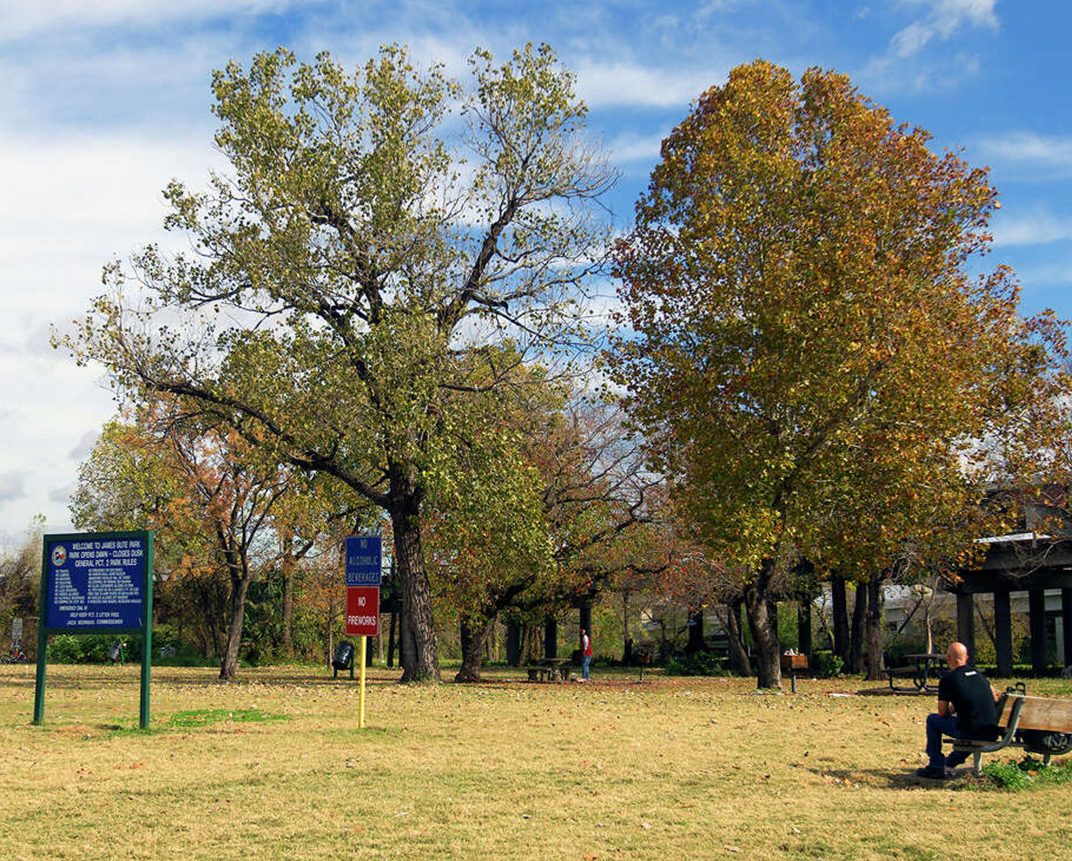

James Bute Park is the original site of Germantown and Frost Town, two early immigrant neighborhoods. In the 1970s, Houston artist Kirk Farris transformed the once-abandoned site into a park named for a Houston entrepreneur who lived nearby. A Texas Historical Marker displayed in the park officially designates Frost Town as a historic site.
McKee Street Bridge
Painted aquamarine, purple, and lavender, the nearby McKee Street Bridge adds a splash of color to the bayou landscape. Kirk Farris is responsible for transforming the bridge that was built in 1932 into a piece of public art.
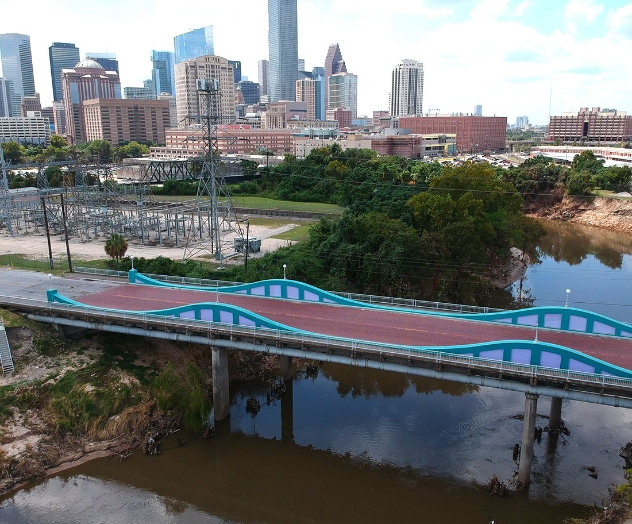

The historic McKee Street Bridge dates back to 1932 and was more recently painted aquamarine, purple, and lavender by Houston artist Kirk Farris.
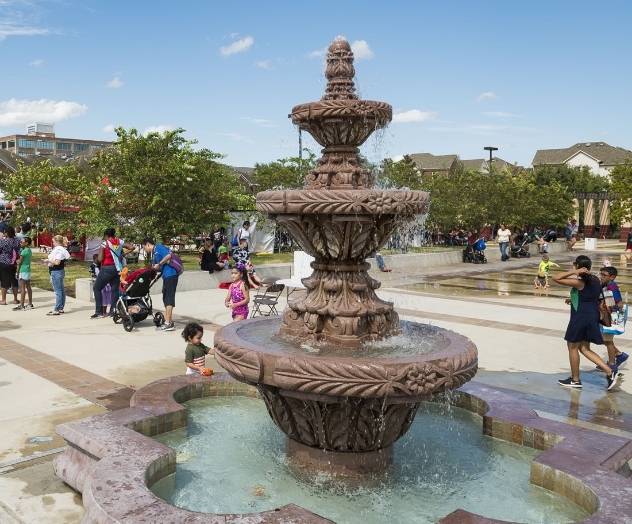

This City of Houston park features green space, trails, and a boat dock as well as interpretive signage about the history of the East End. The Azios family fountain and historic columns are reminiscent of Mexico City’s colonial Zocalo architecture.


Several remnants of the East End’s industrial past can be found along the hike and bike trail. Just east of Jensen Drive, you will discover massive concrete gravel silos now owned by BBP. These tall structures are not only important interpretive landscape elements but the canvas for imaginative public art events.
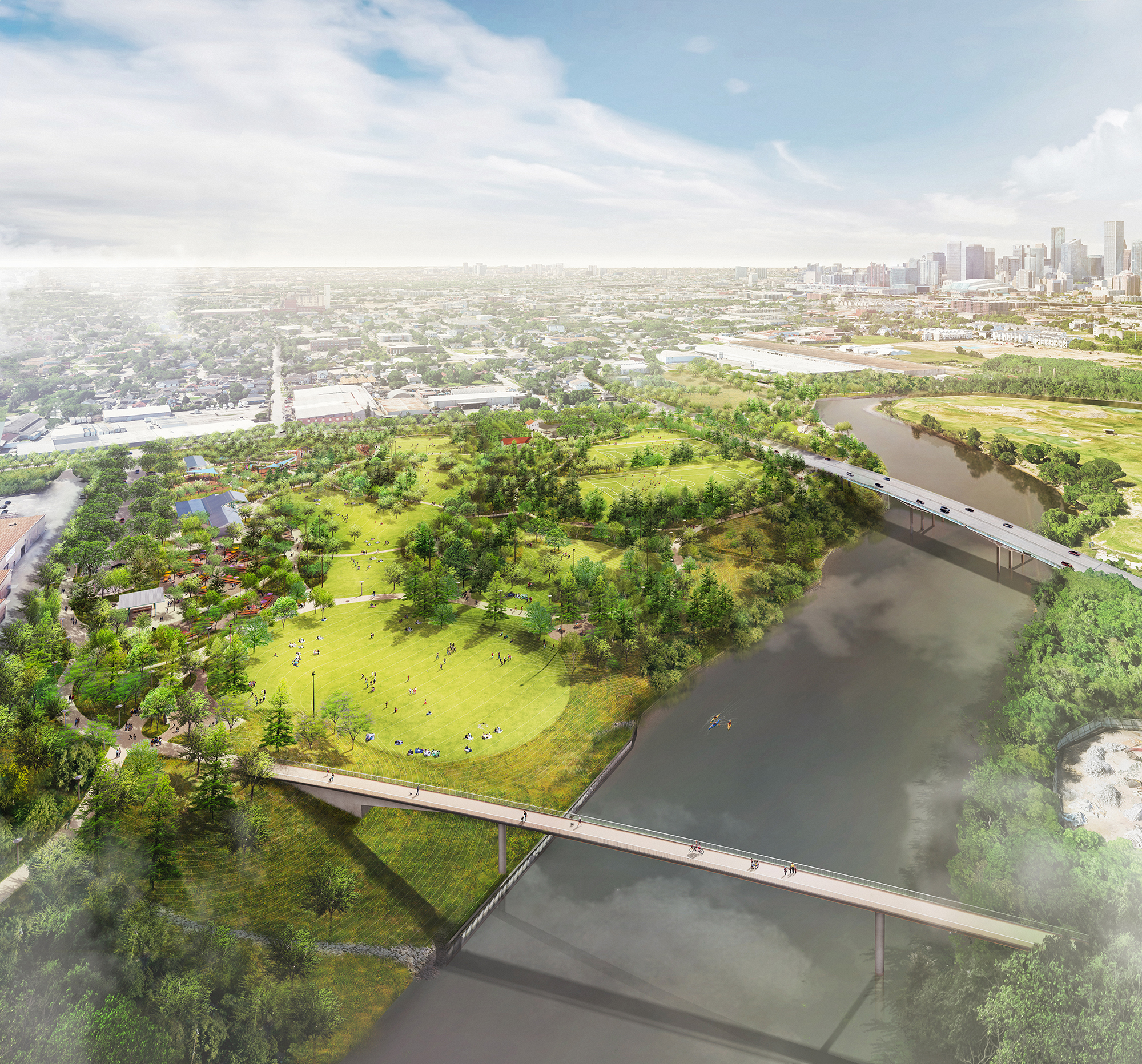

Central to the Buffalo Bayou East Master Plan is the expansion of the City of Houston’s Tony Marron Park from 19 to nearly 40 acres. By 2027, the enhanced park will become the open space anchor for the area, providing residents with a wide range of activities and featuring improved sports fields, new nature play area, and venues for special events and festivals.
Tony Marron Park is currently closed for construction. Learn more about the vision and plans for Tony Marron Park here.
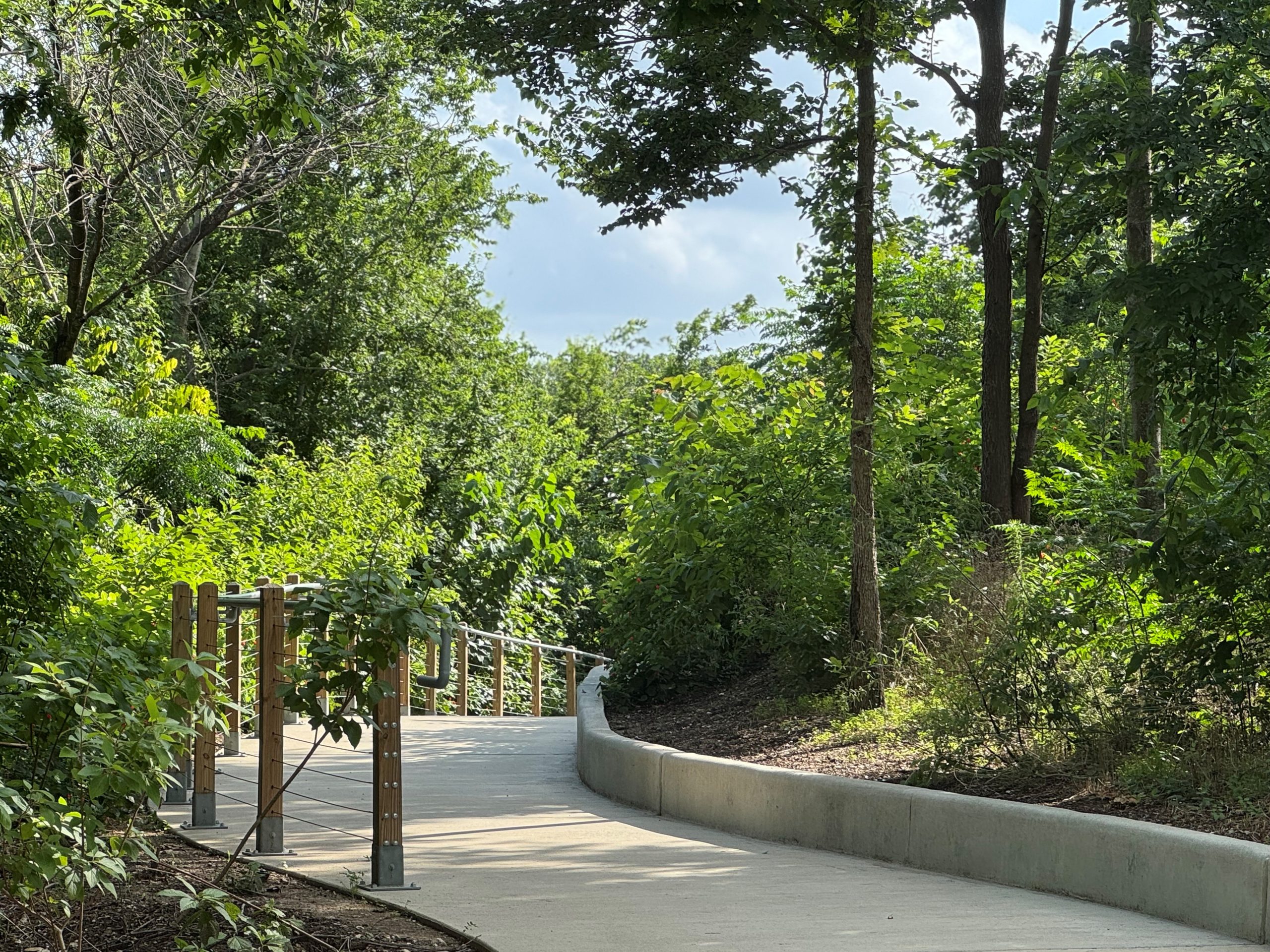

Japhet Creek Park, a 4-acre neighborhood green space, is now open in Houston’s Fifth Ward. Situated along a historic Buffalo Bayou tributary, this pocket park features meadows of wildflowers, accessible walking trails, and open lawns for gathering. The next phase for Japhet Creek is currently in design and will revitalize the creek and build a trail and pedestrian bridge connecting to Tony Marron Park on the south bank.
Learn more about plans for Japhet Creek Park here.
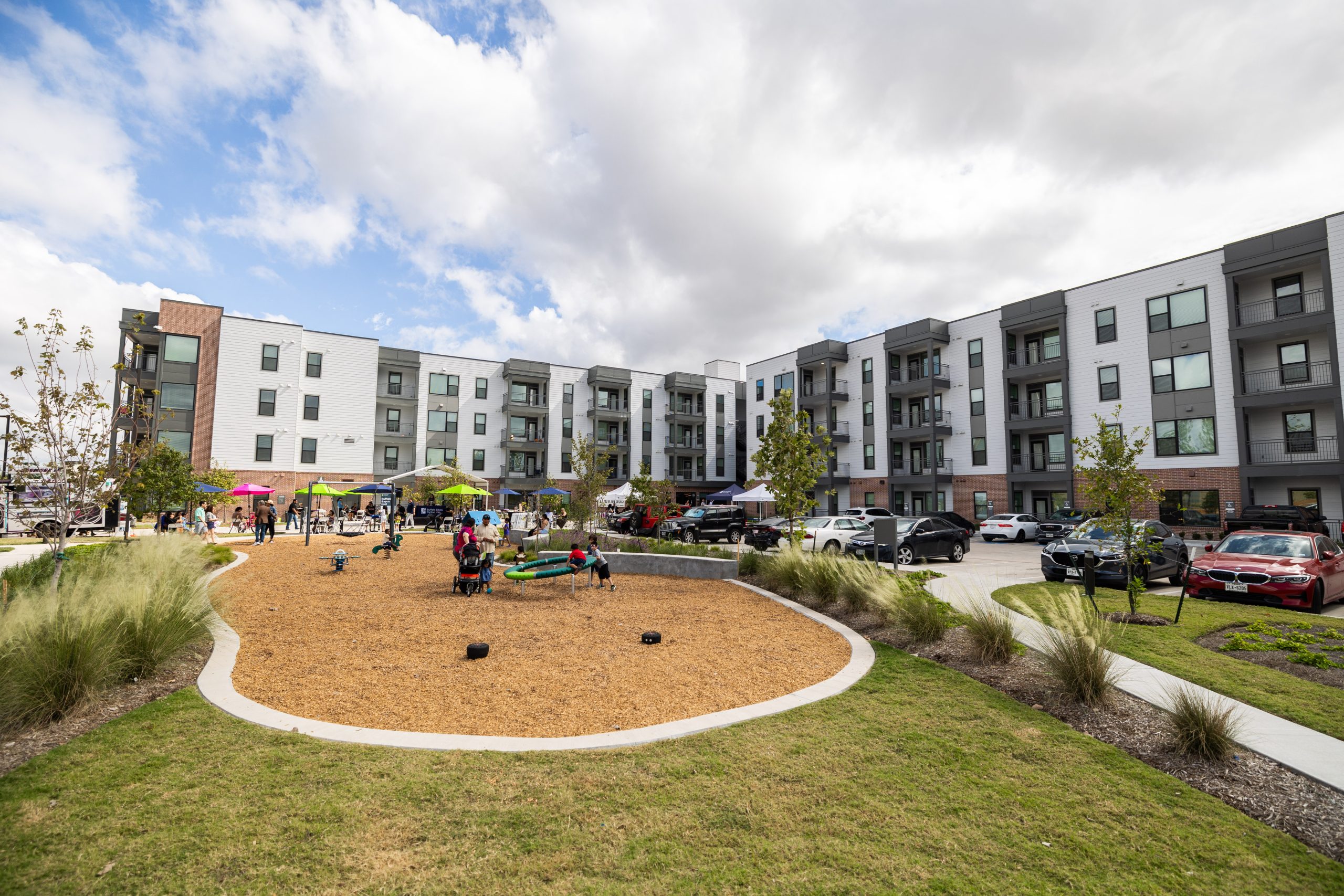

Adjacent to Tony Marron Park, Lockwood on Buffalo Bayou is an affordable housing community created by BBP and its partners. This 80-unit complex of one-, two-, and three-bedroom apartment homes provides expansive bayou views to tenants, shared communal spaces and event rooms, unique murals by local artists, and easy access to hike and bike trails and green spaces.
Learn more about Lockwood on Buffalo Bayou here.
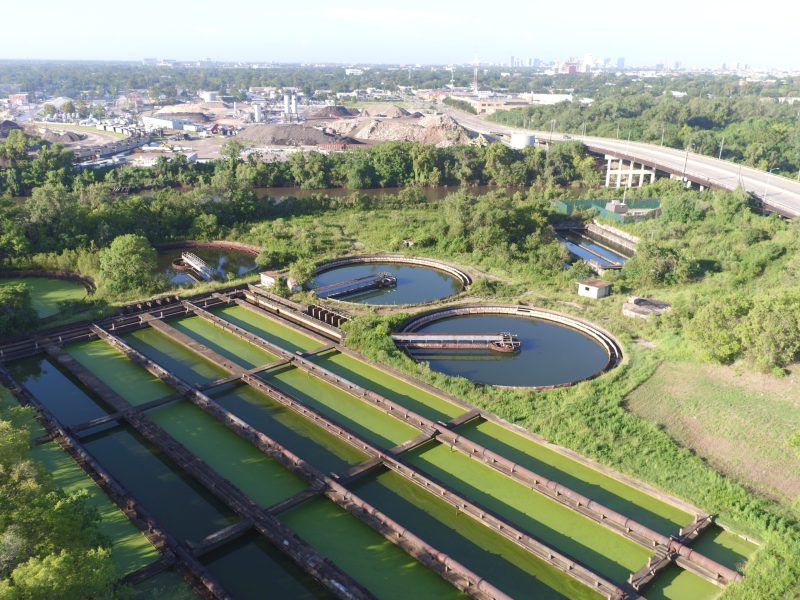

Not currently open to the public.
Decommissioned more than 20 years ago, much of the Northside Sewage Treatment Facility’s infrastructure remains. Aeration and settling tanks, compressor rooms, as well as original pipes and valves are intact. BBP envisions redeveloping the site into a major, regional destination.
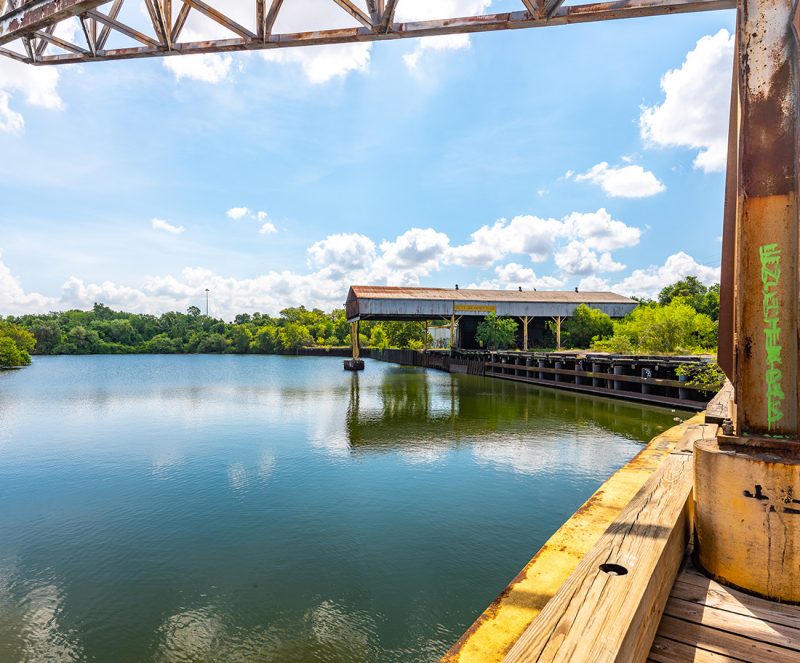

Not currently open to the public.
This dramatic former industrial site along Navigation Boulevard at a stretch of the bayou called Turkey Bend will be transformed by BBP in the coming years into a unique recreational and cultural destination. Future visitors to the site will be able to congregate and relax along the waterfront, attend events and programs of various scales, and participate in boating activities. Learn more about plans for Turkey Bend here.
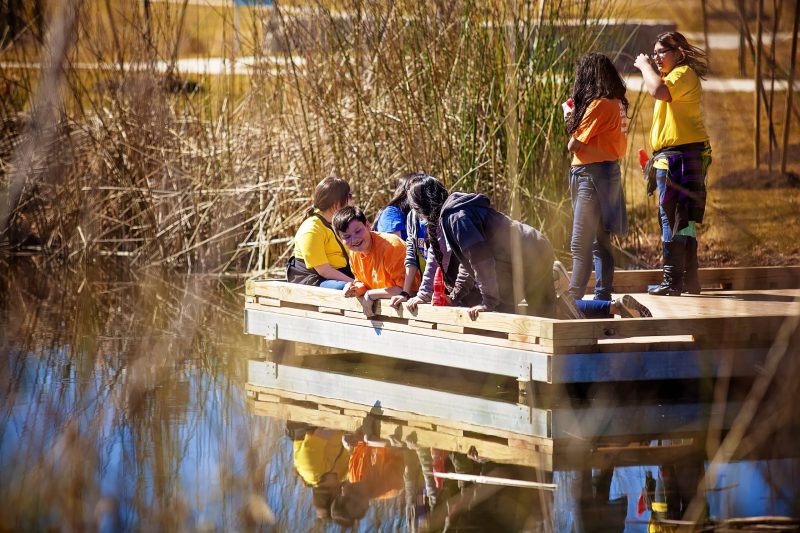

Formerly an industrial property, this 10-acre site was transformed into a natural green space named in memory of Yolanda Black Navarro, a committed civic leader who served Houston for decades. The park features three wetland ponds with an overlook, cistern, native plantings, and footpaths. BBP is working on connecting Yolanda Black Navarro Buffalo Bend Nature Park to the City of Houston’s Hidalgo Park to the east.
HOURS
Open daily from dawn to dusk
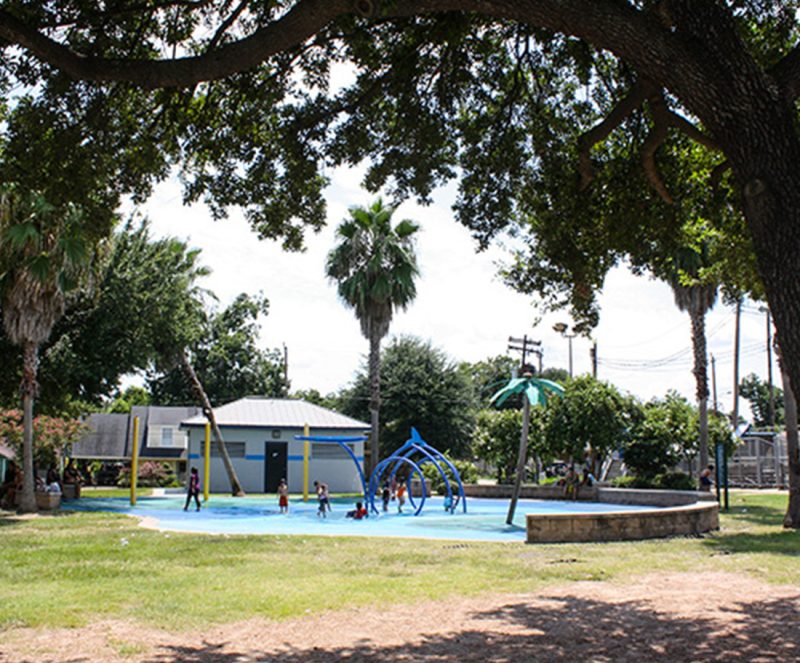

Built in 1932, Hidalgo Park is a popular East End site for Sunday picnics, birthday parties, and baseball games. Neighborhood children enjoy the park’s creative wooden playground and water play station. Among the park’s treasures is a statue of Father Miguel Hidalgo, a gift from the government of Jalisco, Mexico.
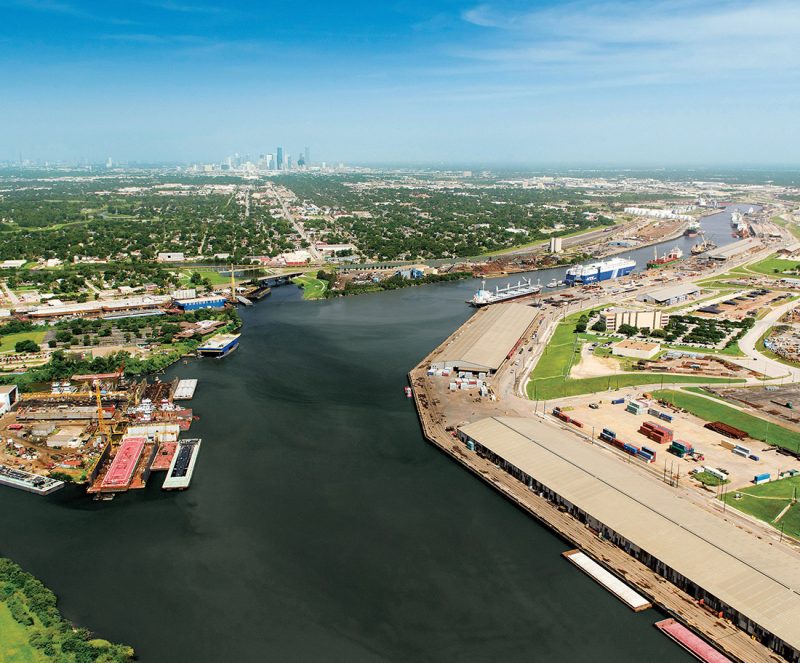

Not currently open to the public.
In 1837, the Allen brothers arranged for the Constitution, a 150-foot steamboat, to visit Houston to dispel doubts about Buffalo Bayou’s navigability. Not being able to turn around once it arrived at its destination, the boat backed down the bayou until it reached a wide enough bend. Dubbed Constitution Bend, the site is now the Port of Houston Turning Basin.


James Bute Park is the original site of Germantown and Frost Town, two early immigrant neighborhoods. In the 1970s, Houston artist Kirk Farris transformed the once-abandoned site into a park named for a Houston entrepreneur who lived nearby. A Texas Historical Marker displayed in the park officially designates Frost Town as a historic site.
McKee Street Bridge
Painted aquamarine, purple, and lavender, the nearby McKee Street Bridge adds a splash of color to the bayou landscape. Kirk Farris is responsible for transforming the bridge that was built in 1932 into a piece of public art.


The historic McKee Street Bridge dates back to 1932 and was more recently painted aquamarine, purple, and lavender by Houston artist Kirk Farris.


This City of Houston park features green space, trails, and a boat dock as well as interpretive signage about the history of the East End. The Azios family fountain and historic columns are reminiscent of Mexico City’s colonial Zocalo architecture.


Several remnants of the East End’s industrial past can be found along the hike and bike trail. Just east of Jensen Drive, you will discover massive concrete gravel silos now owned by BBP. These tall structures are not only important interpretive landscape elements but the canvas for imaginative public art events.


Central to the Buffalo Bayou East Master Plan is the expansion of the City of Houston’s Tony Marron Park from 19 to nearly 40 acres. By 2027, the enhanced park will become the open space anchor for the area, providing residents with a wide range of activities and featuring improved sports fields, new nature play area, and venues for special events and festivals.
Tony Marron Park is currently closed for construction. Learn more about the vision and plans for Tony Marron Park here.


Japhet Creek Park, a 4-acre neighborhood green space, is now open in Houston’s Fifth Ward. Situated along a historic Buffalo Bayou tributary, this pocket park features meadows of wildflowers, accessible walking trails, and open lawns for gathering. The next phase for Japhet Creek is currently in design and will revitalize the creek and build a trail and pedestrian bridge connecting to Tony Marron Park on the south bank.
Learn more about plans for Japhet Creek Park here.


Adjacent to Tony Marron Park, Lockwood on Buffalo Bayou is an affordable housing community created by BBP and its partners. This 80-unit complex of one-, two-, and three-bedroom apartment homes provides expansive bayou views to tenants, shared communal spaces and event rooms, unique murals by local artists, and easy access to hike and bike trails and green spaces.
Learn more about Lockwood on Buffalo Bayou here.


Not currently open to the public.
Decommissioned more than 20 years ago, much of the Northside Sewage Treatment Facility’s infrastructure remains. Aeration and settling tanks, compressor rooms, as well as original pipes and valves are intact. BBP envisions redeveloping the site into a major, regional destination.


Not currently open to the public.
This dramatic former industrial site along Navigation Boulevard at a stretch of the bayou called Turkey Bend will be transformed by BBP in the coming years into a unique recreational and cultural destination. Future visitors to the site will be able to congregate and relax along the waterfront, attend events and programs of various scales, and participate in boating activities. Learn more about plans for Turkey Bend here.


Formerly an industrial property, this 10-acre site was transformed into a natural green space named in memory of Yolanda Black Navarro, a committed civic leader who served Houston for decades. The park features three wetland ponds with an overlook, cistern, native plantings, and footpaths. BBP is working on connecting Yolanda Black Navarro Buffalo Bend Nature Park to the City of Houston’s Hidalgo Park to the east.
HOURS
Open daily from dawn to dusk


Built in 1932, Hidalgo Park is a popular East End site for Sunday picnics, birthday parties, and baseball games. Neighborhood children enjoy the park’s creative wooden playground and water play station. Among the park’s treasures is a statue of Father Miguel Hidalgo, a gift from the government of Jalisco, Mexico.


Not currently open to the public.
In 1837, the Allen brothers arranged for the Constitution, a 150-foot steamboat, to visit Houston to dispel doubts about Buffalo Bayou’s navigability. Not being able to turn around once it arrived at its destination, the boat backed down the bayou until it reached a wide enough bend. Dubbed Constitution Bend, the site is now the Port of Houston Turning Basin.


Lost Lake is the site of a former pond that was lost in the 1970s, when its dam across a natural ravine broke. The pond was restored and is now a tranquil area for reflection, surrounded by beautiful plantings and gentle cascades. Visitors will also find public restrooms and a restaurant here.
FLORA Restaurant at Lost Lake
Please visit the FLORA website for reservations and information.


Watching more than 300,000 Mexican free-tailed bats emerge every evening from the crevices of the Waugh Drive Bridge is truly a spectacular sight. Unlike in other colonies, a large number of these bats remain through the winter months, providing viewing opportunities on warm nights. Stop by at sunset to witness this natural wonder and learn more about the bats through interpretive signage at the viewing platform.
Bat Chats
The Houston Bat Team hosts Bat Chats every Friday, April through October. Please arrive 30 minutes before sunset and meet at the viewing platform at the corner of Waugh Drive and Allen Parkway. Check their Facebook for updates.


At the center of this grove is the Gus S. Wortham Memorial Fountain, affectionately known as the “Dandelion.” The fountain’s brass starburst of pipes sprays joggers, cyclists, and walkers, offering a cool respite from the heat. With shaded overlooks and beautiful plantings, the area is a favorite meeting spot.


Unless you know it’s there, the Green Tree Nature Area may be difficult to find. Located south of Memorial Drive at Waugh Drive, this heavily forested trail is a nature lover’s delight. You will find birds, squirrels, and even a rabbit or two on any given day.


One of Buffalo Bayou Park’s most beloved destinations is the Johnny Steele Dog Park. Dogs have plenty of space to run, swim, and play, while their owners can relax on benches and take advantage of dog washing stations and drinking fountains (complete with spigots for dogs). Limited parking for the dog park is available along the frontage road of Allen Parkway.
DOG PARK REGULATIONS
Hours: 7am – 8pm (may be closed during bad weather or for maintenance)
Closed for maintenance and cleaning Tuesdays 7am – 4pm and Fridays 1 – 2:30pm
The above schedule is subject to change based on cleaning and maintenance needs. Check this page or BBP social media for additional updates.
Help us keep this popular destination safe for dogs and their owners by adhering to these rules:
- Owners are liable for damage or injury inflicted by their dog(s). This means owners are legally and financially responsible for their dog’s behavior. Buffalo Bayou Partnership and the City of Houston have no liability or responsibility for injuries in the dog park.
- Limit of two dogs per person per visit and one hour for each dog.
- Dogs taller than 15 inches may not use the small dog area.
- Dogs must be properly licensed and vaccinated with City of Houston registration and rabies tags visible on each dog’s collar.
- Dogs must be leashed before entering and upon leaving the dog park and must be leashed in the transition area. Owners must have a visible leash for each dog at all times.
- Owners must have disposable pet waste materials visible at all times and must pick up their dog’s fecal matter and dispose of it in a trash receptacle.
- Owners must have verbal and sight control of their dog(s) at all times and prevent aggressive behavior, fighting, biting, and aggressive barking. Never leave your dog(s) unattended.
- Dogs with a known history of dangerous behavior are prohibited. Immediately leash your dog and leave the park if your dog(s) behaves aggressively.
- No puppies under four months of age are allowed in the dog park.
- No female dogs in heat are allowed in the dog park.
- No children aged 12 or under are allowed in the dog park. An adult must accompany children ages 13 through 18. Permitted children must be supervised by an adult and behave appropriately. No running, shouting, chasing dogs, or petting other people’s dogs without their permission.
- No dog or people food is allowed in the dog park.
- No smoking in the dog park or elsewhere in the park.
- Violation of the City Code results in fines and no further dog park use.


Late Texas artist Jesús Bautista Moroles’ Houston Police Officers’ Memorial commemorates the 113+ Houston Police Department officers whose lives were lost in the line of duty. Shaped like an Aztec pyramid, the sculpture symbolizes a royal tomb. The Police Officers’ Memorial and surrounding grounds are guarded 24 hours a day. This is also the site of an annual procession and wreath-laying ceremony.


The late Houston landscape architect Charles Tapley originally designed this inspirational site in the late 1970s that now features a bayou tributary, riparian plantings, granite steps, seating areas, and a footbridge.


Named in honor of the late City Council Member and civic activist Eleanor Tinsley, this “park within a park” is one of Houston’s most popular outdoor spaces with the signature Bud Light Amphitheater lawn and open-air Nau Family Pavilion. Visitors can also enjoy the Eleanor Tinsley Garden and the tranquil Jane Gregory Garden nearby.
Volleyball Court Rentals
The sand volleyball court at Eleanor Tinsley Park is available to rent here.


Here, you will find the Wortham Insurance Visitor Center with restrooms, bike rentals, and staff available to answer your questions and provide directions. Visitors can also enjoy food trucks, stunning views of the downtown skyline from The Brown Foundation Lawn, and frequent performances and events at the Hobby Family Pavilion.
Learn more about renting The Water Works for your own event here.
VISITOR CENTER
Open daily from 9am – 6pm
RESTROOMS
Open daily from 8am – 8pm


The Buffalo Bayou trail system winds through this 23-acre waterfront destination that lies just east of Buffalo Bayou Park. Visitors will find stainless steel boat sculptures by Houston artist John Runnels at major park entrances, BBP’s signature Lunar Cycle Lighting, and the Hobby Pedestrian Bridge, among other features.


This historic park, created in 1899 by Mayor Sam Brashear, was originally landscaped like a Victorian village. Today it is home to The Heritage Society, an organization devoted to preserving a collection of Houston’s historic structures. Nine buildings have been restored and relocated to Sam Houston Park that together tell the story of Houstonians throughout the city’s past.


This 22-acre park is the centerpiece of downtown’s Theater District and commemorates Houston’s 150th birthday. Visitors can stroll along the promenade and take in the public art in the park, including artist Mel Chin’s monumental stainless steel pillars, Seven Wonders.
A bronze statue of former Secretary of State James A. Baker III gazes from the Baker Common across Buffalo Bayou at a statue of former President George H.W. Bush. North Carolina sculptor Chas Fagan created both statues.


Allen’s Landing marks the spot where August Chapman and John Kirby Allen stepped ashore in 1836 and began the transformation of the area from swampy marshlands to the city we know today. This site, at the confluence of Buffalo and White Oak Bayous, became Houston’s first port and a thriving commercial hub. After years of neglect, BBP revitalized this historic site and park into an active waterfront destination. Stainless steel canoe sculptures by John Runnels grace the entrances to the space, and visitors can walk along the wharf where they will find public text art designed by local artist team, ttweak.


The Sunset Coffee Building at Allen’s Landing was built in 1910 by merchant William D. Cleveland to house his coffee roasting operations. It is one of the few remaining industrial buildings on Buffalo Bayou within downtown Houston’s Historic District.
BBP renovated the building in cooperation with Houston First. This industrial building houses BBP’s administrative offices as well as three unique event spaces available to rent, including an indoor space with a balcony overlooking the bayou, a large outdoor plaza, and an intimate rooftop terrace with stunning views of downtown.


James Bute Park is the original site of Germantown and Frost Town, two early immigrant neighborhoods. In the 1970s, Houston artist Kirk Farris transformed the once-abandoned site into a park named for a Houston entrepreneur who lived nearby. A Texas Historical Marker displayed in the park officially designates Frost Town as a historic site.
McKee Street Bridge
Painted aquamarine, purple, and lavender, the nearby McKee Street Bridge adds a splash of color to the bayou landscape. Kirk Farris is responsible for transforming the bridge that was built in 1932 into a piece of public art.


The historic McKee Street Bridge dates back to 1932 and was more recently painted aquamarine, purple, and lavender by Houston artist Kirk Farris.


This City of Houston park features green space, trails, and a boat dock as well as interpretive signage about the history of the East End. The Azios family fountain and historic columns are reminiscent of Mexico City’s colonial Zocalo architecture.


Several remnants of the East End’s industrial past can be found along the hike and bike trail. Just east of Jensen Drive, you will discover massive concrete gravel silos now owned by BBP. These tall structures are not only important interpretive landscape elements but the canvas for imaginative public art events.


Central to the Buffalo Bayou East Master Plan is the expansion of the City of Houston’s Tony Marron Park from 19 to nearly 40 acres. By 2027, the enhanced park will become the open space anchor for the area, providing residents with a wide range of activities and featuring improved sports fields, new nature play area, and venues for special events and festivals.
Tony Marron Park is currently closed for construction. Learn more about the vision and plans for Tony Marron Park here.


Japhet Creek Park, a 4-acre neighborhood green space, is now open in Houston’s Fifth Ward. Situated along a historic Buffalo Bayou tributary, this pocket park features meadows of wildflowers, accessible walking trails, and open lawns for gathering. The next phase for Japhet Creek is currently in design and will revitalize the creek and build a trail and pedestrian bridge connecting to Tony Marron Park on the south bank.
Learn more about plans for Japhet Creek Park here.


Adjacent to Tony Marron Park, Lockwood on Buffalo Bayou is an affordable housing community created by BBP and its partners. This 80-unit complex of one-, two-, and three-bedroom apartment homes provides expansive bayou views to tenants, shared communal spaces and event rooms, unique murals by local artists, and easy access to hike and bike trails and green spaces.
Learn more about Lockwood on Buffalo Bayou here.


Not currently open to the public.
Decommissioned more than 20 years ago, much of the Northside Sewage Treatment Facility’s infrastructure remains. Aeration and settling tanks, compressor rooms, as well as original pipes and valves are intact. BBP envisions redeveloping the site into a major, regional destination.


Not currently open to the public.
This dramatic former industrial site along Navigation Boulevard at a stretch of the bayou called Turkey Bend will be transformed by BBP in the coming years into a unique recreational and cultural destination. Future visitors to the site will be able to congregate and relax along the waterfront, attend events and programs of various scales, and participate in boating activities. Learn more about plans for Turkey Bend here.


Formerly an industrial property, this 10-acre site was transformed into a natural green space named in memory of Yolanda Black Navarro, a committed civic leader who served Houston for decades. The park features three wetland ponds with an overlook, cistern, native plantings, and footpaths. BBP is working on connecting Yolanda Black Navarro Buffalo Bend Nature Park to the City of Houston’s Hidalgo Park to the east.
HOURS
Open daily from dawn to dusk


Built in 1932, Hidalgo Park is a popular East End site for Sunday picnics, birthday parties, and baseball games. Neighborhood children enjoy the park’s creative wooden playground and water play station. Among the park’s treasures is a statue of Father Miguel Hidalgo, a gift from the government of Jalisco, Mexico.


Not currently open to the public.
In 1837, the Allen brothers arranged for the Constitution, a 150-foot steamboat, to visit Houston to dispel doubts about Buffalo Bayou’s navigability. Not being able to turn around once it arrived at its destination, the boat backed down the bayou until it reached a wide enough bend. Dubbed Constitution Bend, the site is now the Port of Houston Turning Basin.
Trail & Visitor Updates
Johnny Steele Dog Park
Closed for maintenance and cleaning Tuesdays 7am – 4pm and Fridays 1 – 2:30pm. Check the Johnny Steele Dog Park page or BBP social media for additional updates.
Upcoming High-Traffic Events & Road Closures
A number of community walks will be using the trails of Buffalo Bayou Park and Allen Parkway in the following months. Please expect increased foot traffic on trails during the following days/times:
- November 11, 9am – 2pm: Houston Salutes American Heroes Veterans Day Parade
- Expected lane closures along Allen Pkwy
- November 15, 8:30am – 12pm: ADA Step Out Walk Houston
- Expected increase foot traffic on trails
- November 27, 6am – 1pm: HEB 76th Thanksgiving Day Parade
- Expected lane closure along Sabine towards Memorial Dr.
Buffalo Bayou East Trail Closures
Various segments of trail are closed for improvements on Buffalo Bayou east of downtown, including a new trail segment being constructed between US 59 and Jensen Drive on the north bank, the existing trail between Jensen Drive and Tony Marron Park on the south bank, and the unimproved trail between Tony Marron Park and Lockwood Drive on the south bank. Please find a map below for current closures.
Buffalo Bayou East Timeline
From 2022 to 2032, numerous parks, trails, pedestrian bridges, and transformed industrial spaces will be constructed and opened to the public as part of the Buffalo Bayou East 10-Year Plan. Find current timing for projects in design and construction here.
Please note that construction timelines are subject to change. Updates will be shared here as available.
Japhet Creek Park
- Construction began: January 2023
- Construction completed: May 2024
Lockwood on Buffalo Bayou
- Construction began: January 2023
- Construction completed: September 2024
Garver Park
- Construction began: May 2024
- Construction completed: October 2025
The Warehouse at Turkey Bend
- Construction began: April 2024
North Bank Hike and Bike Trail – US-59 to Jensen Drive
- Construction began: May 2024
- Construction completes: November 2025
Tony Marron Park
- Construction began: November 2024
- Construction completes: Spring 2027
Marron Park Way
- Construction began: April 2025
- Construction completes: Early 2026
The Wharf at Turkey Bend
- Construction began: August 2025
South Bank Hike and Bike Trail – Jensen Drive to Tony Marron Park
- Construction began: November 2025
- Construction completes: Late 2026
Silos and Stormwater Crossing
- Construction began: November 2025
- Construction completes: Late 2026
Gregg Street Pedestrian Bridge
- Construction began: Summer 2026
- Construction completes: Late 2027
Japhet Creek Trail and Kinder Pedestrian Bridge to Tony Marron Park
- Construction began: Early 2026
- Construction completes: Late 2027

